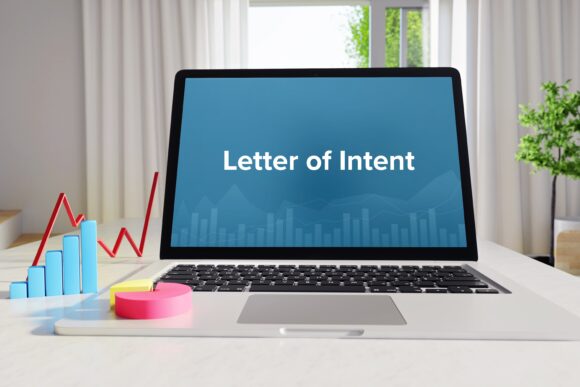When an agency owner decides to sell, there are a plethora of buyers to choose from. A seller should narrow down the options to two or three before serious discussions take place. The next step is to obtain from the buyer a Letter of Intent (LOI), sometimes called a Memorandum of Understanding, or an initial offer letter.
The heart and soul of a business transaction should be embodied in the Letter of Intent. A poorly drafted LOI may render the transaction dead on arrival. On the other hand, a well-drafted LOI provides a solid foundation upon which to build relationships and consummate successful transactions. The prolific buyers all have their own standard format, whereas a first-time buyer might need some support to properly draft an LOI.
The LOI should be a non-binding document written in informal language. The purpose is to put in writing the key terms that both parties have been discussing. The Letter of Intent is also an outline of what is to be included in the final legal documents.
Usually, the LOI is about three or four pages including the items listed below. The draft may require several revisions before all parties agree to sign it. It should be specific and should highlight all of the key areas of the transaction.
The final Letter of Intent should contain all the necessary ingredients for the attorneys to use when they draft the final legal agreements. The terms of the deal should be self-contained in the Letter of Intent. Don’t let the attorneys waste time and money revisiting the terms or re-negotiating the deal unless there is a big oversight or grievous error in the Letter of Intent.
The following is a basic outline of what should be in a Letter of Intent:
- Parties to the Agreement.
Parties to the agreement may include sellers, buyers, consultants, attorneys, accountants, etc.. Clearly set forth the identity and a brief description of each party. Does the other party consist of one or more corporations or partnerships? Is the business an LLC, S-corporation, or C-corporation, etc.? Who are the shareholders or partners and what ownership and management interest do they each hold?
- What the Seller Is Selling and What the Buyer Is Buying.
Is it stock or assets? What liabilities will the buyer assume, if any?
- Structure of the Deal.
Describe the overall business and tax structure of the transaction specifying what will be acquired or sold (e.g., assets or stock). The financial condition of the other party will dictate payment terms, security/collateral, and other key issues. Careful tax planning should be undertaken to determine how to structure the acquisition. Acquisitions may take many different forms including asset or stock sales, combinations of stock redemptions and purchases, or tax-free acquisitions (including mergers and consolidations). Non-competition and consulting, or employment agreements will also usually play a major role. There are many ways that acquisitions can be structured and they all involve their own unique tax, securities, corporate, and other legal issues. Knowing the alternatives and the implications of each can make the difference between making a good deal or no deal.
- The Agreed Purchase Price and Terms.
Describe the down payment, number of payments, and amount of the payments. If the seller is financing the deal what is the interest rate? If the deal is based on retention describe how that will work?
The typical terms include:
- Total purchase price.
- Payment terms.
- Down payment.
- Promissory note terms (interest rate, default, etc.).
- Performance, growth, or bonus payment details.
- Purchase price adjustment assumptions and adjustment events.
- Liabilities to be assumed.
- Allocation of the purchase price. Outline how the purchase price will be allocated if there are any special terms.
One key point to note is that some buyers will state the initial payments as the purchase price and then include potential earn-outs and bonuses, which is a reasonable approach. Occasionally, some buyers will state the price as the initial price, plus all the highest possible bonuses and earn-outs. For a seller, this second approach can be very misleading since the bonuses and earn-outs are not guaranteed. If the purchase price seems extremely high, make sure the buyer describes the guaranteed price versus potential future earn-outs and bonuses.
- Balance Sheet Related.
List any requirements for working capital. Identify any holdbacks that are known, such as a reserve for non-recurring payments — for example, short-term and non-recurring payroll liabilities or rent for an office that will close a few months after closing. Describe how the accounts receivable and accounts payable will be handled. Address the ability to reduce the purchase price in the event that accounts receivable are not collected and whether the purchase price should be adjusted in the event that representations and warranties regarding value are not correct.
- Contingent Income.
Describe how the current year’s contingents will be handled. Usually, the buyer assumes this will belong to the buyer, if received after closing, but it is worth negotiating.
- Security/Collateral.
Identify the security/collateral the buyer will provide as security for any deferred payments. This can include assets of the buyer, personal guarantees, or a stock pledge. This is not an issue with large buyers.
- Transition Terms.
It is often stipulated that the seller will assist in the transition and help with an announcement to clients and companies. If the seller will remain with the business for a while, then an outline of the terms of employment should be listed, including the role, compensation, and duration. List any perks to be paid and insurances for the seller, if any.
- Non-Compete.
The seller is typically required to sign a covenant-not-to-compete for a number of years and may include a radius from the office location. Non-competition restrictions will usually have to be tied to either the current transfer of equity/goodwill or to a future transfer of equity/goodwill.
- Staff.
In some cases, it is helpful to list key employees to be retained. Employment agreements may be needed, and compensation and roles negotiated.
There are standard clauses in most LOIs including:
- Representations and Warranties.
- Confidentiality and Non-disclosure.
- Exclusivity Period.
- Legal/Professional Advisors.
- E&O Tail Coverage Requirements.
- Key Dates and Expected Closing Date.
Within the standard clauses, there will often be contingents to the deal that could impact the terms. These could include:
The assurance and pre-acceptance of the buyer by the seller’s companies.
Securing of any financing by the buyer.
Agreement on both sides regarding the completeness of the final legal documents.
Due Diligence. (See our March 22, 2021, Minding Your Business article for details.)
Summary
A well drafted and negotiated letter of intent can be the key to the success of any transaction. Even though non-binding, it lays the groundwork for the creation of the purchase and employment agreements and will help streamline the process.
Was this article valuable?
Here are more articles you may enjoy.



 Most of 15 Million Bees Saved After Bee-Laden Truck Crashes
Most of 15 Million Bees Saved After Bee-Laden Truck Crashes  Santander Flags Data Breach Hitting Some Clients, All Staff
Santander Flags Data Breach Hitting Some Clients, All Staff  Lindberg Convicted in Second Trial on Attempting to Bribe NC Insurance Commissioner
Lindberg Convicted in Second Trial on Attempting to Bribe NC Insurance Commissioner  18 States Sue Over EEOC’s Policy on Transgender Workers
18 States Sue Over EEOC’s Policy on Transgender Workers 



